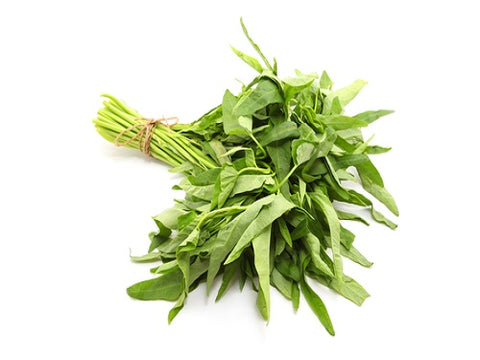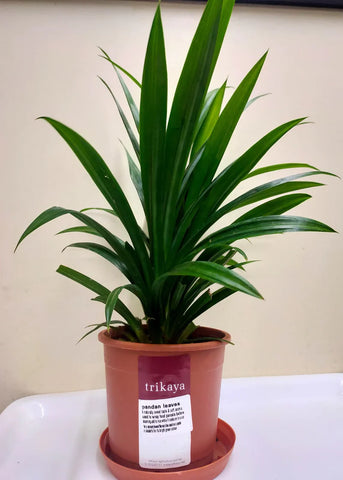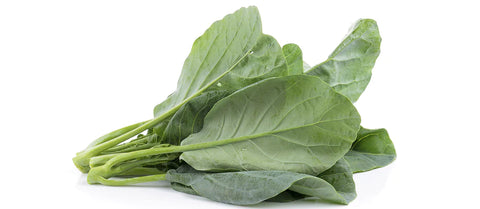
Rs. 100.00
These are scallions with hollow leaves. They have a mild, sweet taste and are prized by chefs for their freshness. Harvested young for their peak flavour. An important element for stir-fries.

Rs. 100.00
Fresh Bamboo shoot is delicious in any stir-fry but please note that it cannot be eaten raw - it can be toxic.
Peel the skin, cut and soak, then boil it for half an hour to remove any bitterness. Brine it or slice and use in stir-fries.
You can add vinegar and/or sliced red chillies while boiling it. It is used a lot in Chinese cuisine as well as in North Eastern cooking and also in Konkani cooking.
Seasonal: Available June-September

Not Available at present - Rs. 460.00
Harvested when young and tender and brined for convenience. A staple of Chinese cuisine, bamboo shoots are best cut into slices and added to stir fries with other vegetables.
Drain from the brine wash under fresh water and then cut and add them to your stir fries, stews or soups.
Taste better after cooking as they loose their slight bitter raw taste and are appreciated for their bite and slight sweet flavour.

Rs. 100.00
The most popular mushroom has found its way in all cuisine. Largely composed of water and shrink noticeably during cooking. Best cooked in butter or a good oil. Fry over a moderately high heat so that as they shrink the water evaporates and they don't stew in their own juices. For the same reason do not fry too many at once in the same pan.
Not Available at present - Rs. 110.00
Milder and sweeter than cabbage. Use in a salad, stir fried or in kimchi.
Rs. 110.00
Galangal is also know as Thai ginger or Siamese ginger but you can not substitute the commonly used ginger for galangal.
Galangal is commonly found in Thai, Indonesian, and Malaysian cooking. The skin of galangal is pinkish, smoother and paler than ginger and its flesh ranges from white to yellow to pink and is much harder. To prepare it for soup or curry, peel off the skin. Its normally not grated like ginger, but is instead normally finely sliced. It also has a whiter flesh and is much denser than ginger. The flavor of galangal is much stronger and more astringent too; it’s earthy, sharp, and extra citrusy. Galangal has a sharp citrusy, almost piney flavor.
Galangal is recognizable by the long pink stalks and pink tips on the root.
Galangal is the khaa in Tom Khaa. Tom kha kai (or tom kha gai) is a Thai soup with the distinct, very Thai flavor of galangal. Kha means "galangal" in Thai. Also used in Tom Yum and curry pastes.
Note: Images are only for illustrative purposes, actual product and colour may slightly differ.

Rs. 150.00
The easiest way to use horseradish is to simply cut off the brown peel and shred or grate some fresh horseradish to serve as a flavoring for hearty soups or stews. Shred as close to serving time as possible, since horseradish turns bitter and discolors within a few hours.
Rs. 190.00
Also called Water Spinach, Kang Kong is an extremely popular and common vegetable in many parts of south-east Asia, grown as a vegetable for its tender shoots and younger leaves. It has a similar flavor and succulent texture to common spinach, with mild, sweet and nutty undertones. Kang kong has a mild flavour and can be used raw in salads as well as lightly cooked. The stem is the main attraction. The stalks are thick, hollow, crunchy things that are great at absorbing flavour. It is generally cooked a minimal time, just enough to wilt it. Like spinach, the leaves cook rather quickly and reduce a lot in volume so don't be afraid to grab a big bunch. When it’s done well, the vegetable will turn vibrantly green and attached with intense flavors from the aromatics it cooked with (its hollow stems may even absorb some of the sauce).
It can stir-fried, steamed, boiled or sauteed with a variety of sauces and served as a side dish. Can also be added to soups and even tempura battered and fried. The hollow stems can also be cooked on their own as a crunchy side dish. Seasonings for cooking this vegetable can be as simple as salt or soy sauce, but they often include a funky fermented paste of some sort, and a touch of sugar.
When preparing, it is best to strip the leaves from the stems and slice the stems diagonally. Add the stems first and stir fry for a minute or so before adding the leaves. Cook only until the leaves are just wilted.
A recipe that is often used is in a hot wok add some oil and 1 tbspn of minced garlic and I cut red chilly (or more) and 1 tspn grated ginger. When fragrant add the chopped kangkong stems and leaves. Add tbspn of any sauce like hoisin, barbecue or oyster sauce along with a little soy sauce. Garnish with red chilly slices and serve. In many parts of Asia it is eaten stir fried with chilli, garlic or a savoury paste.
Kangkong is also known as Morning Glory, Water Convolvulus, Water Spinach, River Spinach and Ipomoea aquatica.
Note: Images are only for illustrative purposes, actual product and colour may slightly differ.

Rs. 80.00
This root is comprised of a cluster of long, slender, orangish brown fingers joined to an insignificant, knobby ginger-like rhizome. It has an exuberant, aromatic quality. The fingers are cut into fine slivers and tossed along with other fragrant herbs into hot-and-spicy seafood stir-fries, curries and soups.
Krachai is not just any rhizome, but a very specific kind with its own distinctive piquant flavor and tangy fragrance that cannot be mistaken with other members of the ginger family to which it belongs. Known also as "lesser ginger", "lesser galangal" and "Chinese key," this root is comprised of a cluster of long, slender, orangish brown fingers joined to an insignificant, knobby ginger-like rhizome. It has an exuberant, aromatic quality. The fingers are cut into fine slivers and tossed along with other fragrant herbs into hot-and-spicy seafood stir-fries, curries and soups.
Kra Chai is a relative of ginger, and is renowned for its sweet taste and peppery bite. While kra chai may offer less of an aromatic bouquet than ginger, it has an unusual lemony aspect.
Kra Chai is mostly used in Southeast Asian cooking, particularly in soups and coconut milk-based dishes. It makes an excellent ingredient for stock, as well as chutney.
The rhizomes are commonly used as vegetables in main dishes or eaten raw when young. It is also popularly used in flavorful curry dishes.
Krachai is generally either grated (most common) or sliced very thin for use in recipes. You can scrape the skin off if you wish but it hardly seems worth the bother. It is most commonly used in curry pastes and as an aromatic vegetable.
Note: Images are only for illustrative purposes, actual product and colour may slightly differ.

Rs. 60.00
Lemongrass is essential for well known Thai dishes like Tom Yum Soup, Green Curry, Massaman Curry, Vegan Stir-Fry and Noodle Soup.
Rs. 100.00
Our oyster mushrooms come in a spectrum of colours - pink, grey, white and yellow. At present we have grey and white. They are often called designer mushrooms due to these unusual colours.
Rs. 180.00
This leafy green Chinese vegetable belongs to the cabbage family (though tastes nothing like cabbage!). It has long green, slightly ribbed leaf stalks and soft oval green leaves. The leaves and stems are best suited to brief stir-frying or steaming to retain their mild flavour.
Rs. 370.00
A delicacy. It has a soft, buttery, crisp and crunchy texture. Similar to artichoke hearts or white asparagus, but way better!
Palm heart is also called Lobster of Vegetables, Swamp Cabbage and Burglar's Thigh.
Great eaten raw in salads and as a snack, it also combines well with a soft cheese. Can also be baked, boiled, stir fried or braised.
Fresh palm heart has a much more subtle and attractive taste than the mushy pre-cooked canned version that most us have tried before. The process of canning destroys most of the charm of eating this vegetable.
Palm Heart is a vegetable harvested from the inner core and growing bud of certain palm trees. Very low in fat and calories.
Harvested from palms planted by Trikaya at our Pune farm, which throw side shoots after planting. These side shoots grow back again, so it is a sustainable form of harvesting palm heart unlike the palm hearts cut from the wild.
Note: Images are only for illustrative purposes, actual product and colour may slightly differ.

Rs. 20.00
Fragrant and aromatic with a naturally sweet taste. Used to wrap food parcels before steaming. Also added to rice while it cooks or in a curry for a savoury and sweet flavour. Also used to flavour many sweets.
In Chinese, it is known as "fragrant plant" because of its unique, sweet aroma. Also known as Pandan Leaf or Screwpine, the leaves are used for their flavor in many Thai and Southeast-Asian dishes.
A small strip of leaf, only a few cm long is added to the pan when rice is cooked to add flavour and fragrance. Slightly longer strips are added to curry to add flavour and they are even used as wraps when steaming to add flavour.
Pandan leaves are used to lend a unique taste and aroma to flavor desserts and drinks as well as savory dishes. Pandan leaves can also be used to wrap savory foods like sticky rice before steaming. The leaves impart these foods with an aromatic note and also give the dishes visual appeal.
Pandan leaves have a naturally sweet taste and soft aroma. Its flavor is strong, described as grassy with hints of rose, almond, and vanilla, verging on coconut. Pandan shares an aroma compound with basmati rice, so some cooks looking to save money will flavor plain rice with pandan.
Pandan's flavour pairs nicely with ingredients such as coconut milk, sticky rice, turmeric, and lemongrass, and it brings a floral essence to desserts. Pandan also adds an interesting and welcome flavor to cocktails.
In Asia, pandan is used as often as vanilla is in western cuisine.
Fresh leaves have the strongest flavor. To make pandan paste, pound fresh, pandan leaves into a paste, removing the fibrous pieces and adding water sparingly. Pandan extract can be made by grinding the leaves with some water and then straining the mixture; the liquid that remains is the extract. Only a small amount of paste or extract is needed when adding to recipes.
Note: Images are only for illustrative purposes, actual product and colour may slightly differ.

Rs. 550.00
Lemongrass is essential for well known Thai dishes like Tom Yum Soup, Green Curry, Massaman Curry, Vegan Stir-Fry and Noodle Soup.
Not Available at present - Rs. 480.00
Fragrant and aromatic with a naturally sweet taste. Used to wrap food parcels before steaming. Also added to rice while it cooks or in a curry for a savoury and sweet flavour. Also used to flavour many sweets.
In Chinese, it is known as "fragrant plant" because of its unique, sweet aroma. Also known as Pandan Leaf or Screwpine, the leaves are used for their flavor in many Thai and Southeast-Asian dishes.
A small strip of leaf, only a few cm long is added to the pan when rice is cooked to add flavour and fragrance. Slightly longer strips are added to curry to add flavour and they are even used as wraps when steaming to add flavour.
Pandan leaves are used to lend a unique taste and aroma to flavor desserts and drinks as well as savory dishes. Pandan leaves can also be used to wrap savory foods like sticky rice before steaming. The leaves impart these foods with an aromatic note and also give the dishes visual appeal.
Pandan leaves have a naturally sweet taste and soft aroma. Its flavor is strong, described as grassy with hints of rose, almond, and vanilla, verging on coconut. Pandan shares an aroma compound with basmati rice, so some cooks looking to save money will flavor plain rice with pandan.
Pandan's flavour pairs nicely with ingredients such as coconut milk, sticky rice, turmeric, and lemongrass, and it brings a floral essence to desserts. Pandan also adds an interesting and welcome flavor to cocktails.
In Asia, pandan is used as often as vanilla is in western cuisine.
Note: Images are only for illustrative purposes, actual product and colour may slightly differ.

Not Available at present - Rs. 60.00
Thai Bird's eye chili are tiny 1 to 1.5 inch chillies range in color from green to red. They are used extensively in many Asian cuisines. The fruits are very pungent.
Its used in soups, salads, and stir-fried dishes. They are also put in a wide variety of sauces, pastes, and marinades, used as a condiment or eaten raw, both fresh and dried.
These chillies are highly valued for their fruity taste and extreme spiciness. They are extensively used in many Thai dishes, such as in Thai curries and in Thai salads, green as well as the ripe red chillies; or they can just be eaten raw on the side.
The bird's eye chili is small, but is quite hot (piquant). It measures around 50,000 - 100,000 Scoville units, which is at the lower half of the range for the hotter habanero (225,000 Scoville units), but still much hotter than a common jalapeño (4000 Scoville units).
The secret to the chilly kick in Thai cuisine.
Note: Images are only for illustrative purposes, actual product and colour may slightly differ.

Not Available at present - Rs. 90.00
Tiniest brinjal ever, literally the size of a pea, hence its also known as Pea Eggplants, Pea Aubergine and Wild Eggplant. These berries look like green peas - it's easy to mistake them for green peas in curries except that they contain brown seeds that lend the berries their bitter flavour.
Green, fresh Pea eggplant fruit is a classic ingredient in Thai dishes like Green curry and chilli sauce. The fruit has a bitter taste but the bitterness is reduced when it has been cooked.
Pea eggplant can be stir-fried, pickled and used in curries or soups. It is very versatile and can be crushed and used to create delicious relishes, sauces and dips. The young fruits are used as fresh vegetable or scalded vegetable to serve with chili paste.
They are typically cooked whole, a slightly bitter flavor and a unique texture that bursts satisfyingly in the mouth when eaten.
Note: Images are only for illustrative purposes, actual product and colour may slightly differ.

Rs. 160.00
Also called Chinese Kale. Blanch in hot water followed by a soak in cold water to retain the colour.
Rs. 30.00
Thai Long Coriander is also called Saw Tooth Coriander, Spiny Coriander, Culantro (not Cilantro). It's native to Central America and the Caribbean, hence why Thais call it 'Foreigner Coriander'. It's mainly used to flavor soups, noodles and curries.
The aroma of Thai long coriander is very pungent and strong. It is similar to fresh coriander leaves, to which they also taste much stronger, but are similar.
The leaves need to be chopped as they are tougher than the regular coriander. The leaves will put up with some cooking unlike regular coriander. Use leaves in stir-fries, soups, salads, curries and salsa.
The first time you smell this herb it will bring back strong memories of the smells of a Thai food kitchen.
Note: Images are only for illustrative purposes, actual product and colour may slightly differ.

Rs. 220.00
Nine Thai ingredients that are normally difficult to find, packed together at a low price to make them accessible to most. We sell each individually also, so click on the name of the herb or spice that you want more detailed information about to go to that page.
Thai Brinjal, Thai Bird Chilly, Thai Sweet Basil, Thai Galangal, Kaffir Lime leaves, Thai Coriander, Kra Chai, Lemongrass, Italian Basil, Pandanus Leaves
Images are only for illustrative purposes, actual product and colour may slightly differ.